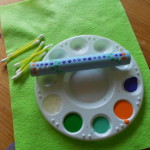How were the first musical instruments created?
It’s most likely they were made from “all natural” materials and were probably the result of wonderful coincidences. Perhaps someone was gathering wood and realized that two sticks tapped together could create a beat. A rock fell on another rock and made a pleasing sound. Bamboo made a wonderful noise when rustling in the wind and inspired Hawaiian rhythm sticks. And since these noise-makers are made of such basic materials, they make great “first instruments” for exploring music with children at home, in the classroom or in the homeschool environment.
Here are three of our favorite “all natural” percussion instruments.
Austalian Clapsticks – “Bilma”
 In Aboriginal Australia, two sticks struck together form a beat that can accompany the didgeridoo and become a part of singing, dancing and celebrating. Whether you tap together two unsharpened pencils or take a nature walk to retrieve two perfect sticks,
In Aboriginal Australia, two sticks struck together form a beat that can accompany the didgeridoo and become a part of singing, dancing and celebrating. Whether you tap together two unsharpened pencils or take a nature walk to retrieve two perfect sticks,  these simple clapsticks can keep a beat while you sing or play along to any your favorite songs.
these simple clapsticks can keep a beat while you sing or play along to any your favorite songs.
If you want to decorate your clapsticks with an Australian theme, you can use a dot motif. In the activity below you can find step-by-step directions for making several different versions of crafty “dot” bilma.
 River Rocks – Hawaiian `ili`ile
River Rocks – Hawaiian `ili`ile
Can rocks make music? Take a nature walk, collect a few and see for yourself.
In Hawaii, special smooth river rocks are part of the hula tradition. These small stones; called ‘ili’ili, are held in a dancer’s hand and tapped together for a percussion sound and that becomes part of the arm movements of the dance. If you want to play “Hawaiian-style”, check out the post below for more about this tradition.
But you can also get creative and make up your own way of “playing rocks”. Try  setting a few rocks out on the ground or table and hold one in your hand. Use the rock in your hand to tap out a beat on one – or several- of the other rocks while you sing along, play recorded music or create your own rhythms with a friend, sibling, parent or fellow musician.
setting a few rocks out on the ground or table and hold one in your hand. Use the rock in your hand to tap out a beat on one – or several- of the other rocks while you sing along, play recorded music or create your own rhythms with a friend, sibling, parent or fellow musician.
Bamboo Rhythm Sticks
 Hawaiian pu’ili are rhythm sticks with one distinct difference. They are made of lengths of bamboo, left whole on one side and split on the other. When tapped together, the split ends rattle against each other making a unique sound.
Hawaiian pu’ili are rhythm sticks with one distinct difference. They are made of lengths of bamboo, left whole on one side and split on the other. When tapped together, the split ends rattle against each other making a unique sound.
Although making traditional bamboo pu’ili is not too hard, it does require some special tools and involves sharp edges. An easier version; especially for young children, can be made from cardboard rolls from paper towels. They are easily  cut and decorated and sound great for percussion play.
cut and decorated and sound great for percussion play.
You can get complete instructions for homemade pu’ili at the post listed below.
Explore Nature and Music
Sticks, stones and reeds can make music. Why not combine an exploration of music and nature to see what kind of inventive creations you can discover and play!
Australian Bilma (From Teachers Pay Teachers)
http://www.teacherspayteachers.com/Product/Australian-Instruments-Make-Your-Own-Bilma-Clapsticks-1133140
Playing River Rocks As An Instrument – Hawaiian `ili`ile
(Post in Making Multicultural Music)
http://makingmulticulturalmusic.wordpress.com/2014/02/13/playing-river-rocks-as-an-instrument-hawaiian-iliile/
 Play Some Pu’ili (Post in Tiny Tapping Toes)
Play Some Pu’ili (Post in Tiny Tapping Toes)
http://www.tinytappingtoes.com/classroom-music/make-your-own-puili-hawaiian-rhythm-sticks/
Musical Craft pdf’s from DARIAMUSIC
http://www.dariamusic.com/crafts.php
E-books, CD’s and more Musical Fun from DARIA’s TeachersPayTeachers Store
http://www.teacherspayteachers.com/Store/Daria-Marmaluk-Hajioannou



Fabulous site! I will surely enjoy!
Pingback: Around The World With Mom's Library - Castle View Academy